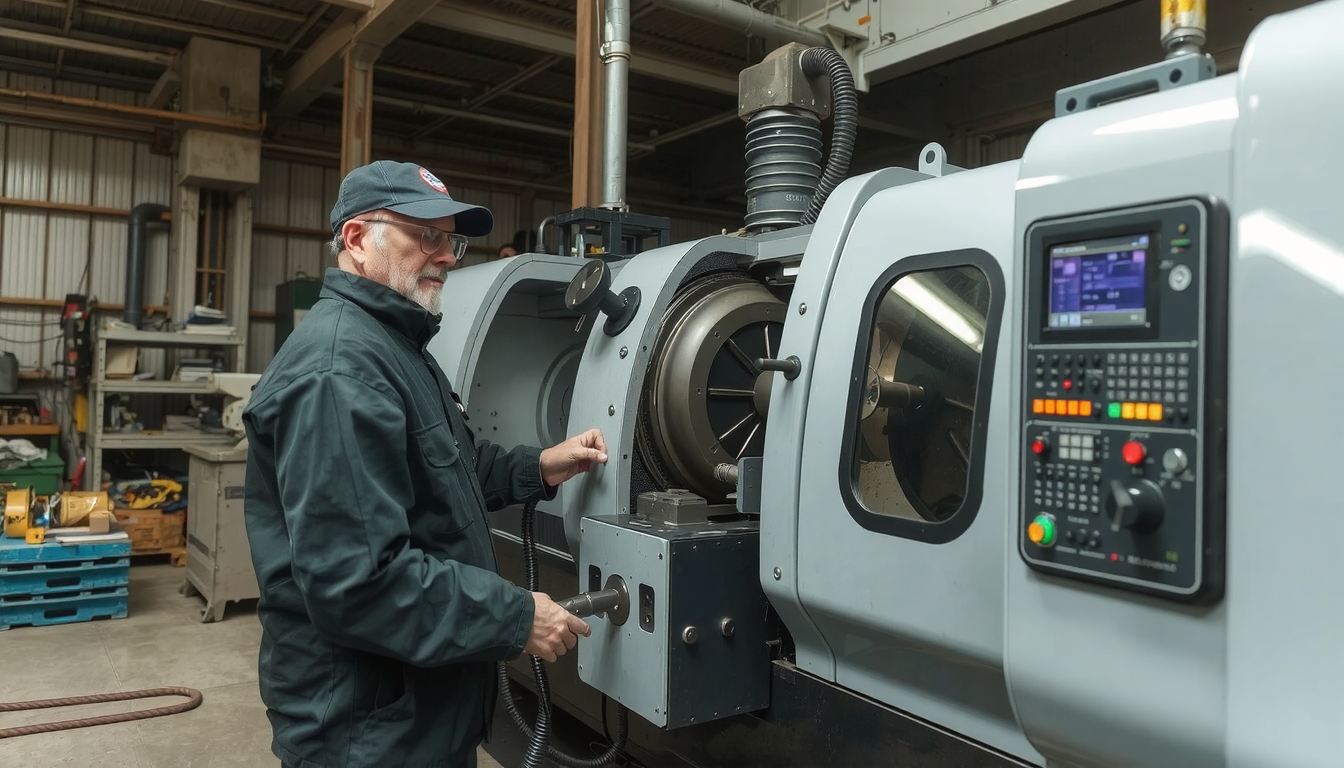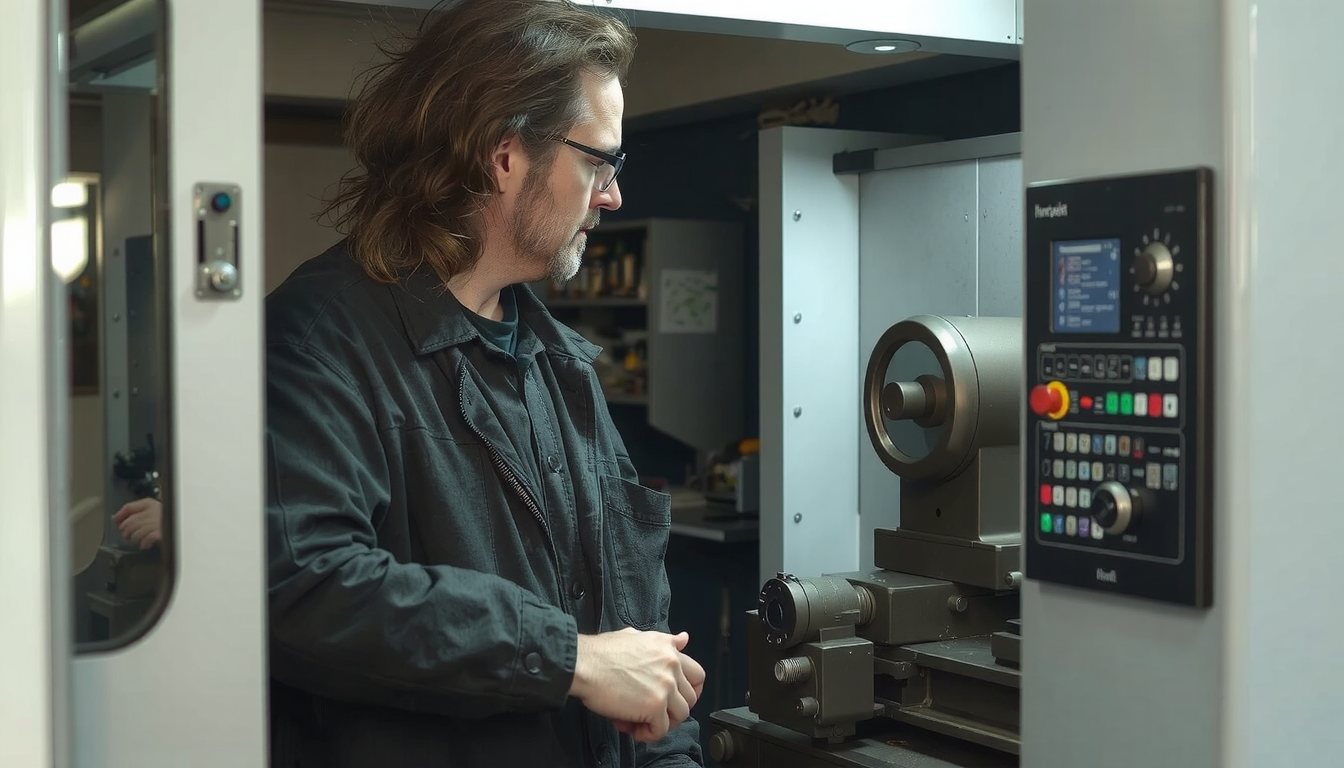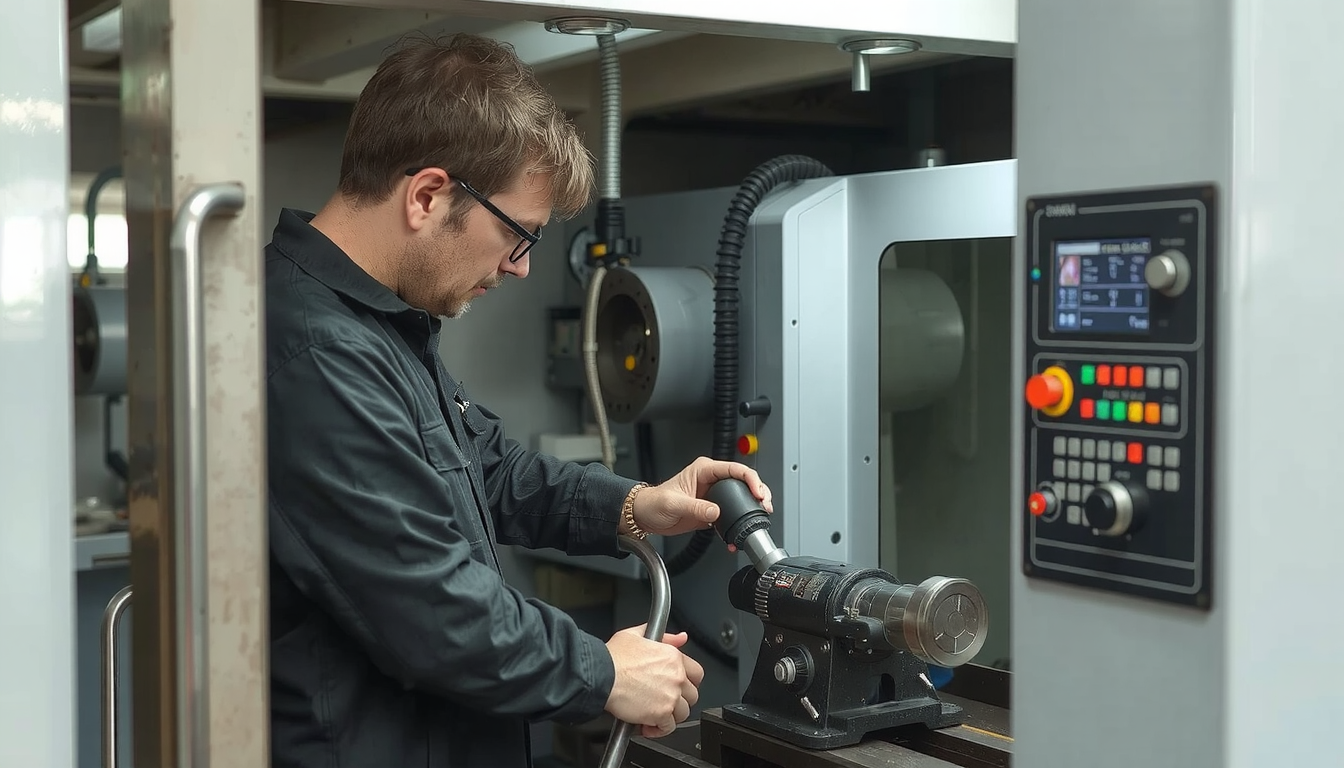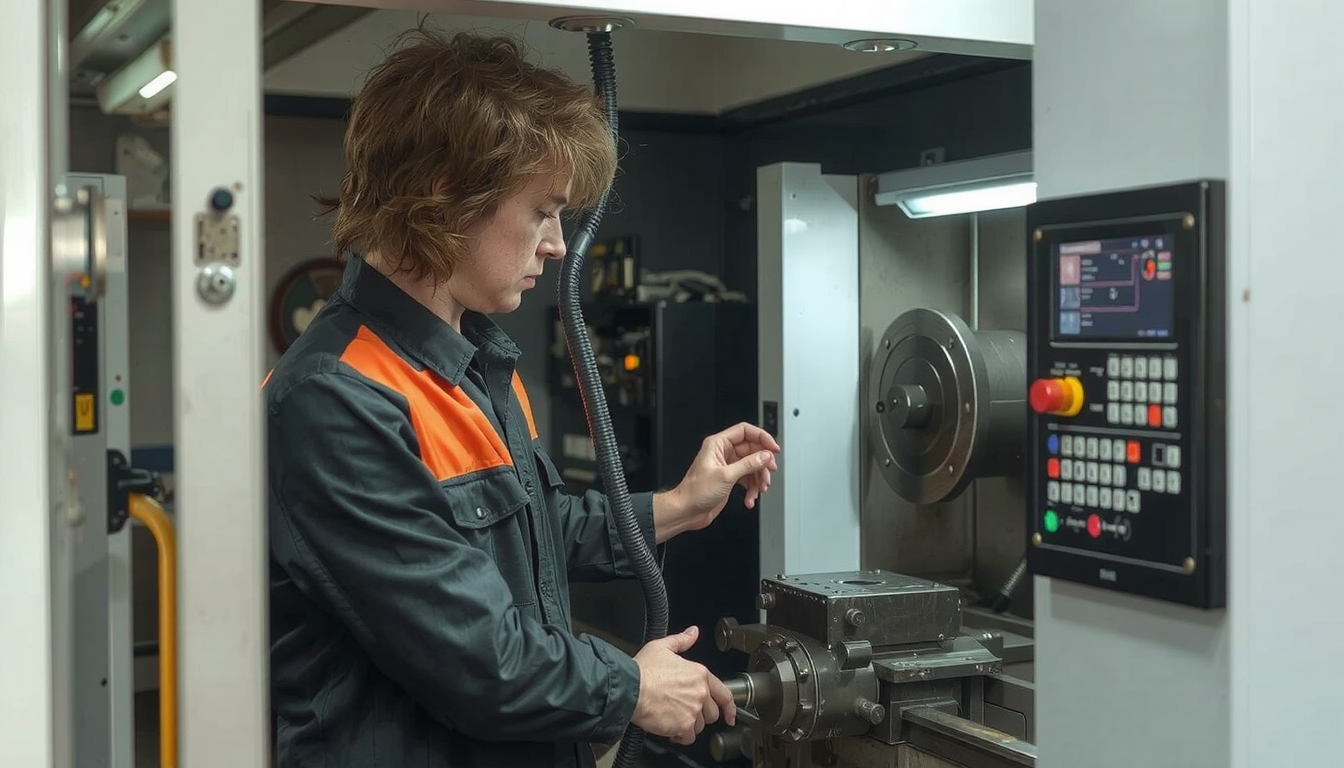CNC lathe machine operation is an easy-to-learn task. You need to work on three vital areas: Safety, Setup, and Execution. A CNC lathe is a type of machine that reshapes metallic parts using a computer program. It spins a piece of material while a cutting tool removes the unnecessary part.

This guide will help you through all the steps. You’ll be introduced to the machine’s components. You will learn how to configure it. You will learn how to run your first program safely. By following these instructions, your skills and confidence will improve greatly.
Safety First: Non-Negotiable Rules
Safety is the foremost thing in learning the operation of a cnc lathe. The consequences can be both dangerous and financial. Always put safety first, even before you press a button.
Средства индивидуальной защиты (СИЗ)
Your personal prevention begins at what you are wearing. There are some items required and others must be avoided.
- Must-Haves: Staying in safety glasses is a must. The steel-toed boots are meant to shield the feet against falling objects.
- Avoid: Loose clothes, rings, watches, or necklaces should not be worn. These can entangle in the liberating machine parts. Long hair should be tied back. Gloves are prohibited when the machine is in use.
Machine Safety Checks
Before initiating the process, you need to examine the machine. Have a good understanding of the machine’s safety features. The doors must be kept closed when a program is in operation. Additionally, never leave a machine running unattended. As a safeguard to yourself and the equipment, always follow the official operator safety guidelines from manufacturers like Haas.
Безопасность рабочего места
A tidy workspace is a safe workspace. The vicinity of the machine should always be free from tools, oil, and any clutter. Metal chips are sharp. Therefore, remove them using a brush instead of your hands. Adhering to these operator safety tips is not an option; it’s a part of the job description.
Understanding Your CNC Lathe

To operate a machine first you need to understand its major components. The knowledge of each piece is necessary for following the instructions. A typical CNC lathe’s main parts are listed below.
- Control Panel: The control panel acts as the brains of the machine. Commands are entered here, programs are loaded, and the machine’s status is monitored.
- Chuck/Spindle: The spindle is the part that rotates while the chuck, which is attached to it, holds the raw material to process, called the workpiece.
- Turret: This is a tool holder that rotates and houses all the tools that the machine will use for a job, such as drills and turning tools, among others. The machine can change them automatically.
- Хвостовая бабка: In case of big parts, the tailstock is used to support the end that is far from the part. This feature limits the bending and vibrating of the part during cutting.
- Ways/Guides: Both the turret and tailstock that glide on these distinct smooth, steel rails which are made of hard steel are called ways or guides. This is how the parts will be precise in their movement.
- Bed: The bed is the stout and heavy foundation of the whole machine. It bears the weight of all components, keeping the whole system stable, secure, and straight.
The 5 Core Steps to Operating a CNC Lathe
How to operate a cnc lathe can be learned through five core necessary steps. From the computer-aided design to the machined component, following this flow ensures accuracy plus safety.
Step 1: Program Preparation
To start, you need a program. The program is a set of instructions that tell the machine what to do, in the form of G-code, a computer language that can be understood by the machine. The machine moves, spins, and works with tools according to this code. Commonly, the G-code is generated via CAD and CAM software. These programs convert 3D models into toolpaths.
Step 2: Machine Setup and Workholding
More so, you prepare the machine next. This means turning it on, “homing” it which is the action whereby the machine is sent to its default start position. Then, you need to securely fasten your raw material into the chuck. The workpiece must be held tight enough not to move or to fly away during the procedure.
Step 3: Tool Setup and Offsets
At this point, load the cutting tools into the turret. It is necessary to carry out the measurement on all tools. The tools are positioned by the operator who is the person measuring the tool against a sensor or the part itself. This is how the machine learns the length and position of each tool. The data recorded in the tool offset are the information address.
Step 4: Setting the Work Offset (G54)
The machine is aware of the position of its tools, however, it does not know the location of your part. Thus, you need to set the work offset, which is very often referred to as G54. This indicates to the machine that the program’s zero point is already defined this is typically the face of the workpiece. This procedure ensures that the machine will be placed correctly in the program.

Step 5: Program Execution and Monitoring
Finally, the job is all set for you to run. Load your G-code first into the control. It is wise to carry out a dry run” before running the program. This is the act of running a program without part and in this case, it will keep the tools at a distance from the part being worked on. As a result of this, you can observe the movements of the tool and look them over for mistakes. After you confirm that the route is clear, the program can be switched on, and the part can be made. During the entire process, make sure you keep a close eye and ear on everything.
Your First Cut: A Practical Walkthrough
Theoretical knowledge is one thing, but the actual experience of making the first cut is another. And so, here is an applied checklist to direct you through a simple facing and turning operation.
Pre-Flight Check
So, think like a professional pilot. Before you click the Start button, it would be necessary to go through this checklist once more.
- Is the emergency stop button easy to reach?
- Am I wearing my safety glasses?
- Is the workpiece tight enough in the chuck? Give the part a pull test to ensure its position.
Setting Offsets with Caution
Be careful when you touch off your tools. It is during this time that mistakes usually happen.
- Use the handwheel to move the turret at a slower speed. Never use the rapid traverse button to approach near a part or sensor.
- Please be sure to double-check the tool number that you are saving your offset in. If not, you will have Tool 1’s offset saved incorrectly in the T1 space.
The Safety Run (Dry Run)
This action is key in preventing a crash.

- After your G54 work offset has been set, go back to the Z-axis value it was previously. Add 5 inches to it. For example, you could change Z0 to Z5.0.
- The program should run either in “Graphics” or in the air. The tools would move just like they should be doing, however, they will do so 5 inches in front of the part.
- Observe the toolpaths. Do they seem correct? Are they too near to the chuck jaws? This check will save you from most of the severe crashes.
Making the First Cut
Time has come to make chips.
- Change your Z-axis work offset back to the original setting (Z0).
- Activate the “Optional Stop” (M01) command on the control. With this on the machine will stop after each tool change. This will allow checking and adjustments.
- Reset the “Rapid Override” dial to 25% which is a lower setting. This will cause every fast operation to slow down. As a consequence, you would have more time to react if anything goes wrong.
- Breathe deep, and, with the hand, press the Cycle Start button. After the part is subjected to the cut, watch the tool while it approaches it. Most importantly, listen to the sound of the cut. A pleasant and smooth sound is a sign of a successful cut.
Becoming skilled in the operation of a CNC lathe is indeed a rewarding ability to obtain. However, very complicated works may need the expertise of professionals. Professional Услуги токарного станка с ЧПУ can assure high-quality and fast results even in demanding conditions.
5 Common Beginner Mistakes and How to Avoid Them
Every newbie operator is bound to make some errors. Knowing the common ones will help you to avoid them. Here are five of the most frequent errors and how to prevent them.
| Mistake | The Consequence | How to Avoid It |
|---|---|---|
| 1. Forgetting Tool Nose Compensation | Your part will have wrong diameters and angled surfaces. | Always use G41/G42 in your program. Make sure the tool’s corner radius is entered correctly in the tool offset page. |
| 2. Rapid Move (G00) into the Part/Chuck | A serious crash that breaks the tool and damages the machine. | Always program a safe Z-position to pull away to before moving in the X-axis. Always perform a dry run to verify the toolpath. |
| 3. Incorrect Work Offset (G54) | The machine cuts in the wrong spot or crashes into the chuck. | Improve your Z-zero touch. For the first part, use a scale or caliper to measure the distance from the tool tip to the part face. |
| 4. Wrong Spindle Direction (M03/M04) | The tool will just rub on the part and break. | Use M03 for normal, right-hand tools (spindle turns clockwise). M04 is for special left-hand tools. Watch the spindle spin before it cuts. |
| 5. Using Worn-Out Tooling | The part will have a bad surface finish and wrong size. | Listen for changes in the cutting sound. Check your tool tips often. If you are not sure if a tool is good, change it. |
Conclusion: Your Journey to Skilled Operation
The journey of mastering the operation of a cnc lathe machine involves a positive health foundation. This is a careful setup process requiring constant attention during execution. Each part you make adds to your experience and eventual skill in the process.
There isn’t a better way to hold practice than through experience. The machine will become your friend as long as you spend more and more time with it. Keep learning, and stay safe, and be proud of the parts you make. This is a skill you will use in various fields in modern manufacturing.
Stay tuned and sample more sectors in manufacturing technology with Mekalite.
FAQ: Frequently Asked Questions about Operating a CNC Lathe
1. How long does it take to learn to operate a CNC lathe?
Within a few days, you can learn how to load parts into the machine and basic to operate it. This takes place when the machine is already set up. Attaining the level of a skilled setup operator who can prepare new jobs from a blueprint requires several months or a year of regular indepth training.
2. Is operating a CNC lathe dangerous?
Every type of powerful machinery carries risks. However, CNC lathes are built with safety measures that ensure adequate prevention of problems. The operation can be very secure by following all the safety measures, using the guards of the machine, and by never letting your guard down. Newer machines have the technology necessary to help the operator.
3. Do I need to know how to write G-code to operate a CNC lathe?
No, for simple operation you will just need to know basic codes and nothing more. It is very important to learn G-code for setting up new jobs or for troubleshooting them. Even if the CAM software should write the program, the code being clear shows you how to edit and solve problems at the machine.
4. What is the difference between a CNC lathe and a CNC mill?
The main difference is the gripping element, the part that spins while the other is fixed. This is the ideal method for manufacturing round parts. Conversely, CNC mills perform the opposite, the spindle turns and the tool is moved around a workpiece that remains fixed. This is typically used to make square, blocky parts and complicated designs.
5. What is a “machine crash” and how do I prevent it?
A crash is when the machine moves in a way that was not planned. This causes a tool to collide with the part, chuck, or another machine component at high speed. The best ways to prevent this are to always perform a dry run. Double-check all your tool and work measurements. Use the rapid override on the first run. This procedural discipline is a core part of any complete starter guide to lathe operation.

